Displaying items by tag: Paul Clitheroe
Sailing's Best Christmas Panto Is Sydney-Hobart Race
As anticipated here a week ago, the annual 629-mile Rolex Sydney Hobart Race kept offshore racing and nautical entertainment addicts all around the world enthralled through the Christmas period. And it has produced a story to suit almost all tastes. The crowded windward start in Sydney Harbour was exciting – too exciting for some. Then out in the Tasman Sea there was an on-the-nose gale, as expected. There were calms towards the end, as seems inevitable. And the big beamy 100ft American girl Comanche (Jim & Kristy Hinze Clark skippered by Kenny Read) finally got her coveted line honours win.
The hotly-sailed TP 52 Balance, owned and skippered by Australian financial guru Paul Clitheroe, took the Holy Grail (aka the Tattersall’s Cup) for the overall IRC win. And second place went to Fastnet Race 2015 overall winner Gery Trentesaux with one of the all-conquering JPK 10.80s. But the Trentesaux silver medal was only won by a whisker ahead of the restored veteran S&S 34 Quikpoint Azzurro (Shane Kearns).
In all, it has been quite a story, though admittedly Irish hopes were disappointed in that Gordon Maguire, reckoned to be among the Tattersall’s contenders at mid race aboard Matt Allen’s Carkeek 60 Ichi Ban, had to be content with eighth overall on IRC at the finish. But he was second in IRC Div 0, and sixth in line honours. As for the new Mark Mills-designed 45ft Concubine (Jason Ward), she was right in the middle of the rating range which did least well, but still managed a sixth in Division 1. W M Nixon casts an eye over a vintage staging of a great race.
We’re tempted to introduce a new acronym in reporting – IANMTU. But as such a word probably couldn’t exist in any language, we’ll make it IANTU so long as everyone understands that it means: I Am Not Making This Up. And it will have to do, as there was IANTU rampant before the Hobart fleet had even got out past Sydney Heads.
Things were potentially sticky as the forecast north to northeast breeze for the first day of the race actually had much less east in it than expected, making it a tight-packed beat out of an already crowded harbour.
But it’s one very major highly-publicised event. So instead of using their trusty old workhorse of a regular committee boat, the organising Cruising Yacht Club of Australia planned to fire the starting signal cannons from a class of a superyacht appropriate to the presence of celebrities and sponsors aboard to honour this premier sailing event of the Australian yachting calendar. And IANTU, but didn’t the superyacht start taking on water as the countdown began? And she took on water with such superyacht-style speed that the great and the good on board had to be hastily landed two miles up the harbour at a pier called (IANTU) Zoo Wharf.
Fortunately the club’s trusty workhorse committee boat was out and ready to take over starting duties. But there wasn’t time to transfer the official starting cannons from the immersing superyacht which was looking sleeker by the minute up at Zoo Wharf. However, the regular boat did have a horn of sorts, so the 71st Rolex Sydney-Hobart Race started not with a bang, but a toot, which we’ll suppose was a sort of nautical whimper.
It very soon became a proper start to a great race nevertheless, but getting out of the harbour was a bit of a melee, and of course with a fleet which included an unprecedented visiting 26 nations, wasn’t it one of the highest profile visitors – the Chinese TP 52 Ark323 whose tyro crew has already sailed thousands of often rugged miles just to be there – which came out on the wrong side of some shunting among the group of TP 52s and similarly-sized craft, and was so damaged that she had to retire before getting to the open sea?
Later in Hobart, it was adjudged that another TP 52 was at fault. This was the famous Syd Fischer’s Ragamuffin 52, which was being raced by his grandson Brenton, as Syd himself – now aged 88 – was racing aboard his super maxi Ragamaffin 100. That gives you some insight into the depth of involvement the great Australian sailing families have with the annual Hobart thrash. But the fact that the grandson and his crew were penalized, after an otherwise quite good race, was scant consolation for the Chinese crew, who saw more than a year of effort and intense training go straight down the tubes in one short sharp incident.
There was nothing at all amusing in it. But before the fleet had cleared the harbour with one or two other less damaging scrapes, there was entertainment on the sidelines among the spectator fleet. There, a little old motorboat – definitely not a superyacht – decided to emulate the official start boat by leaking so much that her doughty skipper with his motley crew headed pronto for the nearest beach which (IANTU) happened to be a popular nudist bathing venue. The resulting much-photographed scenes of some rescuers in the nip led to the 71st Rolex Sydney-Hobart Race getting more publicity in the worldwide popular press than it has done since the tragic events of the ultra-stormy race of 1998.
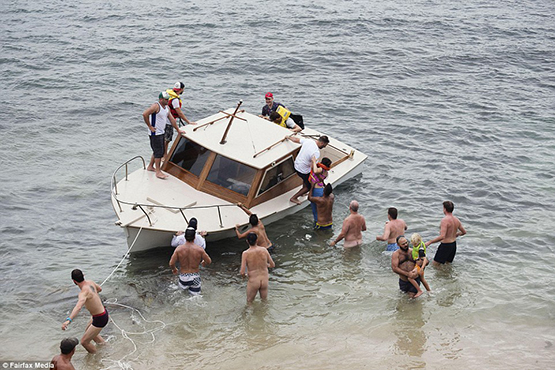
It could only be Sydney Harbour. One of the spectator boats found she was sinking off a nudist beach.
But meanwhile there was a proper serious race taking shape. In the short sharp beat to the harbour mouth, amongst the maxis Anthony Bell in command of his hundred foot Perpetual Loyal (ex Rambler 100) found himself in a minority of one by holding to the starboard side in the rising breeze, but he’d made the right call. Perpetual was at the harbour-exiting turning mark clear ahead - but only just. Comanche and the much-altered Wild Oats XI were right behind her, and out in open water with plenty of breeze and freed sheets, Comanche simply became a different sort of animal altogether. She roared away into the lead, while among those trying to hang onto her coat-tails, it was notable that George David’s smaller Rambler 88 was punching way above her weight - she was dealing with the Tasman Sea’s rough and irregular waves as though she was sailing in smooth water.
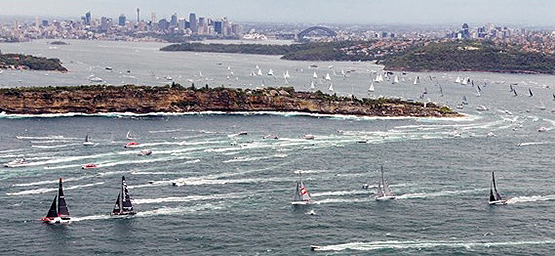 Clear the way…..having reached open water, Comanche is seen here streaking away from Perpetual Loyal, Wild Oats XI, Ragamuffin 100, and Rambler 88. Photo: Rolex
Clear the way…..having reached open water, Comanche is seen here streaking away from Perpetual Loyal, Wild Oats XI, Ragamuffin 100, and Rambler 88. Photo: Rolex
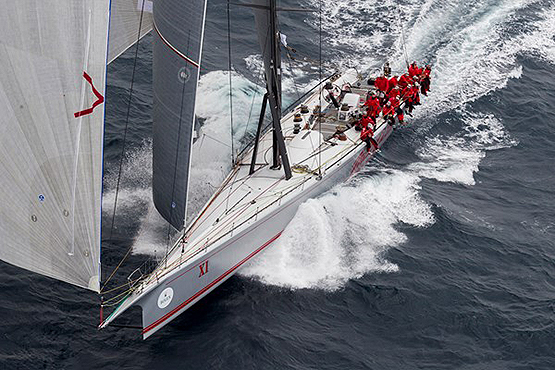 When the going was good……the new-look extra-skinny Wild Oats XI making knots on Day 1 when the wind was fair. But that night’s Southerly Buster shredded her mainsail, and she retired. Photo: Rolex
When the going was good……the new-look extra-skinny Wild Oats XI making knots on Day 1 when the wind was fair. But that night’s Southerly Buster shredded her mainsail, and she retired. Photo: Rolex
This was all splendid mile-eating stuff while it lasted, tearing along on port with every stitch set and water flying all over the place. But everyone knew only too well that the first night would bring a classic Southerly Buster, gusting to 45 knots bang on the nose.
The underlying south-going stream was in fine form, so this would inevitably create horrendous wind-over-tide conditions when the new wind arrived. Except that a regular tidal cycle changes every six hours. The worst of normal wind-over-tide conditions will last only 4 to 5 hours. But this south-going stream continues regardless of the local state of the tide. Thus everyone prayed that the front at the heart of the Southerly Buster would go through in a reasonable time. It didn’t. The ferocious slugging match lasted around 18 hours. It was boat-breaking, gear-wrecking, crew-bashing stuff.
The litany of damage was comprehensive. The remarkable thing is that only 30 boats felt they’d no option but to pull out. The highest profile exit was by Wild Oats XI. The sudden nature of the change in conditions is indicated by the fact that as night drew on, one of the most experienced crews in the race were so suddenly hit by a squall of 40 knots-plus, and from the opposite direction to the day’s wind, that by the time they’d got things back under some sort of control, their mainsail was torn beyond all use and repair, and Wild Oats XI soon retired.
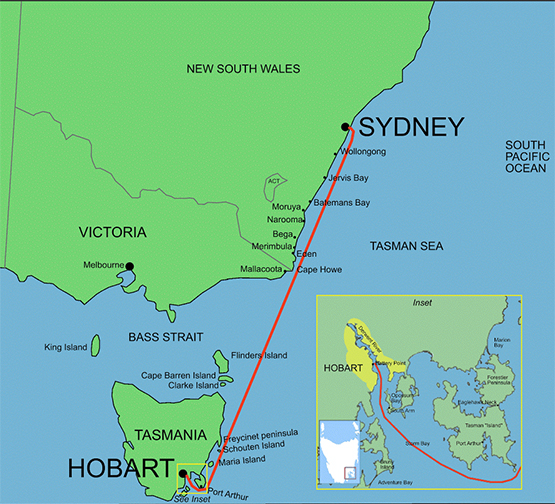 By heading south the Sydney-Hobart course takes the fleet into ever more rugged waters
By heading south the Sydney-Hobart course takes the fleet into ever more rugged waters
Ragamuffin 100 was likewise taken totally aback, but though she lay completely on her ear over to port with the canting keel deployed in the totally wrong direction for fifteen minutes, somehow they got it all back together again with the mainsail still intact and nobody lost over the side, though some of them had spent rather longer in the Tasman Sea than they might have wished. Their troubles weren’t over, as they soon broke off a daggerboard. But they managed to get it clear and drilled a hole in the foot of the other daggerboard to take a line so that they could haul it up again when it was needed to move it to the other side.
Meanwhile Perpetual Loyal “sailed fast straight off a cliff”, and landed with such a bang that she sustained sufficient hull damage to make urgent retirement a necessity while she could still look after herself. Rambler 88 also had damage to both daggerboard and rudder, yet reckoned she still had enough bits hanging on to get to the finish with a bit of nursing. However, up ahead Comanche had sustained so much damage to a daggerboard and rudder she was for a while officially recorded as being retired. But then Kenny Read and his crew took another look at it and decided that as they’d come so far to do the race, and as it wasn’t that far to Hobart, they’d limp along to the finish somehow or other, though any chance of a record was out of the question.
With the fleet order taking shape, special interest focused on the Carkeek 60 Ichi Ban and Rupert Henry’s Judel Vrolik 62 Chinese Whisper, as the pundits reckoned this was the boat size best suited to the forecast pattern of wind conditions. Indeed, so firmly had this prediction become that Matt Allen – having kept his options open by also having an entry in for his TP52 Ichi Ban I – chose between his two boats by going for the Carkeek, with the TP 52 staying behind in dock.
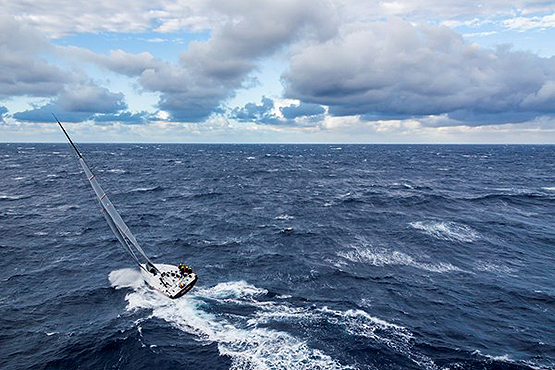 A long way to go, and a lot of southerly wind to get through – Ichi Ban slugs it out in open water. Photo: Rolex
A long way to go, and a lot of southerly wind to get through – Ichi Ban slugs it out in open water. Photo: Rolex
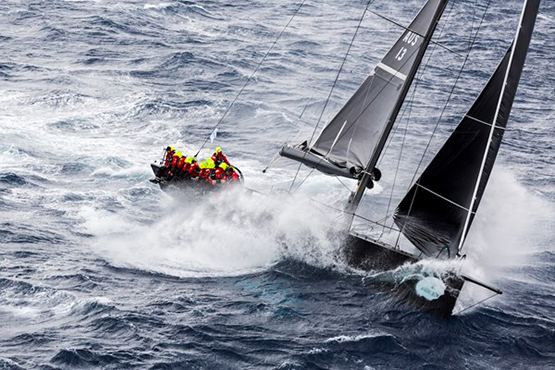
The low-freeboard JV 62 Chinese Whisper was originally the successful day racer Spirit of Jethou, but she seemed to cope more than reasonably well with rugged offshore stuff. Photo: Rolex
The irony of this decision in light of the final overall result cannot be denied. But it should be pointed out that though the TP 52 Balance won overall, of seven TP 52s starting, only three finished, the other being the penalized Ragamuffin 52, with the third one Damien Parkes’ Duende aboard which Tony Cable was doing his 50th Sydney-Hobart Race. So who knows whether Ichi Ban I would have made it, whereas the hefty Carkeek 60 came through with style.
But as has been remarked before, maybe the 60ft Ichi Ban is just a bit too hefty. Certainly she is markedly different from Chinese Whisper, which in the end beat the Allen-Maguire team by an hour and nine minutes. The Whisper is one interesting boat. Originally she was Spirit of Jethou, designed in 2009 by Judel Vrolik and built by Green Marine to be a 60ft day racer – hence her low freeboard - for Peter Ogden. In 2012, with input from Brad Butterworth, she was lengthened by two feet and optimised for the Mediterranean circuit, in which she swept all before her.
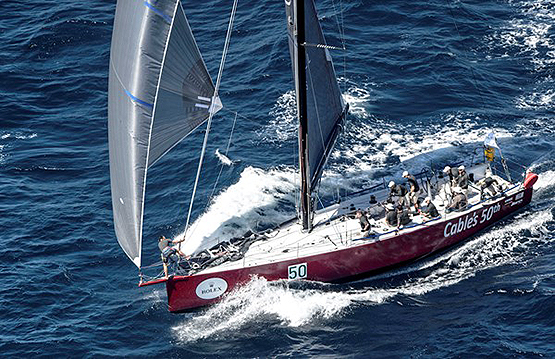
The TP 52 Duende (Damian Parkes) placed 7th in the PHS Division, while it was the 50th Sydney-Hobart Race for crewman Tony Cable. Photo: Rolex
That this “inshore racer” has now won her class in the toughest Sydney-Hobart race since 2004 speaks volumes for her basic qualities. And though she has become 2ft longer than Ichi Ban, somehow she manages to rate 1.489 to Ichi Ban’s 1.501. That tiny margin makes for a huge difference when the two boats are racing neck-and-neck for much of the course, and particularly when, in the latter half of the race, Chinese Whisper tended to be always around a mile nearer the finish.
As for the eventual overall winner Balance, while she may have started with the prospect of boat-for-boat racing against other TP 52s, by the finish she was very much alone, but fortune was with her, and she’d a splendid sail in a private breeze making 16 knots and better for the final approaches to the Derwent and the tricky last few miles to the Hobart waterfront.
Even once she was in, so many other boats were still out racing with a good chance to beat her on corrected time that crew members who hadn’t signed up to sail the boat back to Sydney flew back home to spend the last of Christmas with their families. But within a couple of days, their skipper was on the phone to get them to fly south again for the prize-giving, as they’d won the Tattersall’s Cup.
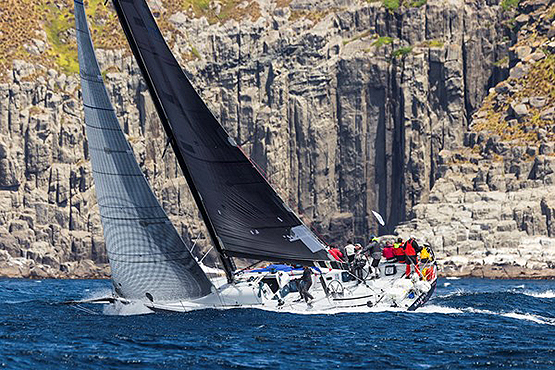
Overall winner Balance with her much-repaired mansail finds smoother water in under the Tasmanian coast. Photo:Rolex
It had seemed a long wait for a boat which, as Quest, had been overall winner of the 2008 race. At first Skipper Clitheroe could only give out about the sheer roughness of the sail, and wonder why he did this sort of thing at all, and how his crew had miraculously kept his very damaged mainsail in one piece “using every last bit of stickyback on board”.
But then as each challenger failed to make the necessary finishing time, Balance’s position looked firmer than ever. The Reichel Pugh 51 Primitive Cool (John Newbold) was a contender, but missed. For a long time, Eric de Turckheim’s Archambault 13 Teasing Machine from France looked very good indeed, but she too missed the slot. Then for some giddy hours the great Gery Trentesaux, overall winner of the Rolex Fastnet Race 2015, looked as though he might complete an astonishing double, but he too fell short.
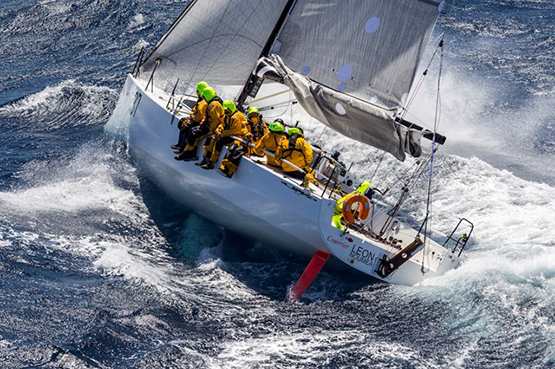
Good in all conditions – Gery Trentesaux, overall winner of the Rolex Fastnet Race in August, on his way to second place overall in the Rolex Sydney-Hobart Race in Courrier Leon. Photo: Rolex
So then as the clock ticked on, the only boat left to push Balance off her perch was the veteran S&S 34 Quikpoint Azzurro (Shaun Kearns), by which time the story was writing itself. Paul Clitheroe is, among other things, a financial guru with a TV programme on money management, while Shane Kearns broke all the rules on prudent money management by buying an old semi-derelict S&S 34 with his credit card, and then splashing out further with the plastic by optimising the boat such that with her Australian coachroof and bowsprit, you’d be hard put at first to guess this was an S&S 34 whose design dates from 1969.
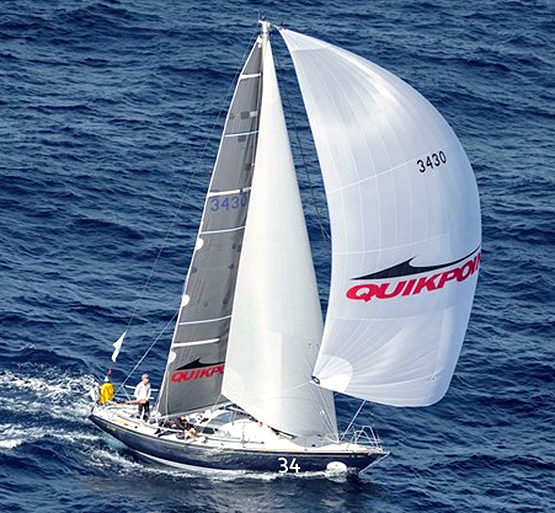 Little old boat that nearly made the top title. The beautifully-restored veteran S&S 34 Quikpoint Azzura (Shane Kearns) for some hours looked like being the overall winer but the flukey winds of the Derwent saw her slipping and she placed third, just six minutes behind second-placed Courrier Leon. Photo: Rolex
Little old boat that nearly made the top title. The beautifully-restored veteran S&S 34 Quikpoint Azzura (Shane Kearns) for some hours looked like being the overall winer but the flukey winds of the Derwent saw her slipping and she placed third, just six minutes behind second-placed Courrier Leon. Photo: Rolex
Yet even Quikpoint Azzurra, rating way down at 0.926, failed to make it. Indeed, so excruciatingly slow were her final miles that she finally lodged in third overall behind Gery Trentesaux, who was sailing a sister-ship of the boat with which he won the Fastnet, This was a JPK 10.80 which happened to be cruising the Pacific, but was re-routed to Sydney for the Trentesaux team to turn up with a new suit of sails, including a specially reinforced mainsail.
That special mainsail proved to be one of the veteran skipper’s best decisions - and he has made many good ones. And we now also know that all the questions after the 2015 Fastnet win, wondering just how good the incredibly successful JPK 10.80 design would be in a real breeze of wind, have been very satisfactorily answered out in the rough Tasman Sea.
The corrected times of the top ten boats in the Rolex Sydney-Hobart Race 2015 say everything about the remarkable diversity of the fleet. And the IRC has given a reasonably good account of itself, with just 52 minutes covering the seven boats between 2nd and 7th in a difficult race.
Rolex Sydney-Hobart Race 2015 IRC Overall:
1st Balance (2008 TP 52, Paul Clitheroe, NSW) CT 04:07:27:13;
2nd Courrier Leon (2013 JPK 10.80, Gery Trentesaux, France) 04:10:02:53;
3rd Quikpoint Aazzura (1973 S&S 34, Shane Kearns, NSW) 04:10:09:01;
4th Primitive Cool (2010 Reichel Pugh 51, John Newbold, Victoria) 04:10:36:19;
5th Chinese Whisper (2009/2012 Judel Vrolik 62, Rupert Henry NSW) 04:11:39:18;
6th Wild Rose (1987 Farr 43, Roger Hickman, NSW) 04:11:41:53;
7th Teasing Machine (Archambault 13, Eric de Turckheim, France) 04:11:54:47;
8th Ichi Ban (2014 Carkeek 60, Matt Allen NSW) 04:12:48:46;
9th Mayfair (2010 Beneteau First 40, James Irvine, Queensland) 04:14:29:56;
10th Imagination (2004 Beneteau First 47.7, Robin Hawthorne, NSW) 04:14:58:17.






















